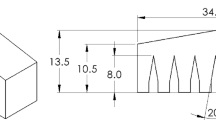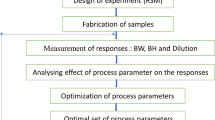Abstract
Additive manufacturing (AM) has various independent parameters that affect the mechanical properties and quality of the produced parts that are not linearly the function of each other. Process parameters in metal AM are very hard to control, analyse and optimise because they affect each other even though they can be independently changed. Changing process parameters in a wide range is not possible due to the formation of problems such as cracks, balling, unmelted powders, porosity and distortion. In this paper, a numerical model to predict the value of tensile strength of selective laser melting (SLM) Ti-6Al-4V parts and analyse the effect of process parameters on the results has been proposed. Taguchi L25 Design of Experiment (DOE) across 125 samples to create a comprehensive and general overview of influential parameters on the build process was investigated. Specifically, parameters included laser power, scan speed, hatch spacing, laser pattern angle and heat treatment (HT). To evaluate and analyse the build process according to established statistical variances, a minimum of five samples based on ASTM standard (for tensile test) were prepared. Heat treatment was added to the DOE to analyse the combined process and post-process effects. Results were compared (cross-validated) against existing values found in the literature and were found to effectively predict and explain the behaviour of tensile strength when changing process parameters.
Similar content being viewed by others
References
Khorasani A, Gibson I, Goldberg M, Littlefair G (2017) Production of Ti-6Al-4V acetabular shell using selective laser melting: possible limitations in fabrication. Rapid Prototyp J 23(1):110–121
Gong H, Rafi K, Gu H, Janaki Ram GD, Starr T, Stucker B (2015) Influence of defects on mechanical properties of Ti–6Al–4V components produced by selective laser melting and electron beam melting. Mater Des 86:545–554
Kadirgama K, Harun WSW, Tarlochan F, Samykano M, Ramasamy D, Azir MZ, Mehboob H (2018) Statistical and optimize of lattice structures with selective laser melting (SLM) of Ti6AL4V material. Int J Adv Manuf Technol 97(1):495–510
Zhang P, Zhang DZ, Peng D, Li Z, Mao Z (2018) Rolling contact fatigue performance evaluation of Ti–6Al–4V parts processed by selective laser melting. Int J Adv Manuf Technol 96(9):3533–3543
Boschetto A, Bottini L, Veniali F (2018) Surface roughness and radiusing of Ti6Al4V selective laser melting-manufactured parts conditioned by barrel finishing. Int J Adv Manuf Technol 94(5):2773–2790
Khorasani AM (2017) The selected laser melting production and subsequent post-processing of Ti-6Al-4V prosthetic acetabular. Deakin University
Gibson I, Rosen DW, Stucker B (2015) Additive manufacturing technologies. Springer
Teng C, Pal D, Gong H, Zeng K, Briggs K, Patil N, Stucker B (2017) A review of defect modeling in laser material processing. Addit Manuf 14:137–147
Gong H et al (2014) Analysis of defect generation in Ti–6Al–4V parts made using powder bed fusion additive manufacturing processes. Addit Manuf 1:87–98
Gong H, et al. (2014) Melt pool characterization for selective laser melting of Ti-6Al-4V pre-alloyed powder. In Solid freeform fabrication symposium
Prashanth KG, Scudino S, Eckert J (2017) Defining the tensile properties of Al-12Si parts produced by selective laser melting. Acta Mater 126:25–35
Hassn AH, Christopher S, Liang H (2018) Effect of build orientation on the surface quality, microstructure and mechanical properties of selective laser melting 316L stainless steel. Rapid Prototyp J 24(1):9–17
Rao H, Giet S, Yang K, Wu X, Davies CHJ (2016) The influence of processing parameters on aluminium alloy A357 manufactured by selective laser melting. Mater Des 109:334–346
Khorasani A, Gibson I, Goldberg M, Littlefair G (2017) On the role of different annealing heat treatments on mechanical properties and microstructure of selective laser melted and conventional wrought Ti-6Al-4V. Rapid Prototyp J 23(2):295–304
Yadroitsev I, Krakhmalev P, Yadroitsava I (2014) Selective laser melting of Ti6Al4V alloy for biomedical applications: temperature monitoring and microstructural evolution. J Alloys Compd 583:404–409
Cao S, Chu R, Zhou X, Yang K, Jia Q, Lim CVS, Huang A, Wu X (2018) Role of martensite decomposition in tensile properties of selective laser melted Ti-6Al-4V. J Alloys Compd 744:357–363
Cai C, Gao X, Teng Q, Li M, Pan K, Song B, Yan C, Wei Q, Shi Y (2018) A novel hybrid selective laser melting/hot isostatic pressing of near-net shaped Ti-6Al-4V alloy using an in-situ tooling: interfacial microstructure evolution and enhanced mechanical properties. Mater Sci Eng A 717:95–104
Savalani MM, Pizarro JM (2016) Effect of preheat and layer thickness on selective laser melting (SLM) of magnesium. Rapid Prototyp J 22(1):115–122
Yadroitsev I, Krakhmalev P, Yadroitsava I, Johansson S, Smurov I (2013) Energy input effect on morphology and microstructure of selective laser melting single track from metallic powder. J Mater Process Technol 213(4):606–13
Gustmann T, Neves A, Kühn U, Gargarella P, Kiminami CS, Bolfarini C, Eckert J, Pauly S (2016) Influence of processing parameters on the fabrication of a Cu-Al-Ni-Mn shape-memory alloy by selective laser melting. Addit Manuf 11:23–31
Dai D, Gu D, Zhang H, Xiong J, Ma C, Hong C, Poprawe R (2018) Influence of scan strategy and molten pool configuration on microstructures and tensile properties of selective laser melting additive manufactured aluminum based parts. Opt Laser Technol 99:91–100
Spierings A, Herres N, Levy G (2011) Influence of the particle size distribution on surface quality and mechanical properties in AM steel parts. Rapid Prototyp J 17(3):195–202
Joguet D, Costil S, Liao H, Danlos Y (2016) Porosity content control of CoCrMo and titanium parts by Taguchi method applied to selective laser melting process parameter. Rapid Prototyp J 22(1):20–30
Bikas H, Stavropoulos P, Chryssolouris G (2016) Additive manufacturing methods and modelling approaches: a critical review. Int J Adv Manuf Technol 83(1–4):389–405
ASTM (2014) Additive Manufacturing Titanium-6 Aluminum-4 Vanadium with Powder Bed Fusion. ASTM. p. 1–9
Roy RK (2010) A primer on the Taguchi method. Society of Manufacturing Engineers
Khorasani AM, Gibson I, Goldberg M, Littlefair G (2016) A survey on mechanisms and critical parameters on solidification of selective laser melting during fabrication of Ti-6Al-4V prosthetic acetabular cup. Mater Des 103:348–355
Boyer R, Welsch G, Collings EW (1994) Materials properties handbook: titanium alloys. ASM international
Khorasani AM, Jalali Aghchai A, Khorram A (2011) Chatter prediction in turning process of conical workpieces by using case-based resoning (CBR) method and taguchi design of experiment. Int J Adv Manuf Technol 55(5–8):457–464
Ruck DW et al (1990) The multilayer perceptron as an approximation to a Bayes optimal discriminant function. IEEE Trans Neural Netw 1(4):296–298
Khorasani AM, Yazdi MRS, Safizadeh MSJIJOE (2011) Tool Life Prediction in Face Milling Machiningof 7075 Al by Using Artificial Neural Networks (ANN) and Taguchi Design of Experiment (DOE). Int J Eng Technol 3(1):30
Khorasani A, Yazdi MRS (2015) Development of a dynamic surface roughness monitoring system based on artificial neural networks (ANN) in milling operation. Int J Adv Manuf Technol:1–11
Mertens A, Reginster S, Paydas H, Contrepois Q, Dormal T, Lemaire O, Lecomte-Beckers J (2014) Mechanical properties of alloy Ti–6Al–4V and of stainless steel 316L processed by selective laser melting: influence of out-of-equilibrium microstructures. Powder Metall 57(3):184–189
Khorasani A, Yazdi MRS (2017) Development of a dynamic surface roughness monitoring system based on artificial neural networks (ANN) in milling operation. Int J Adv Manuf Technol 93(1–4):141–151
Pupo Y, Monroy KP, Ciurana J (2015) Influence of process parameters on surface quality of CoCrMo produced by selective laser melting. Int J Adv Manuf Technol 80(5–8):985–995
Rafi H et al (2013) Microstructures and mechanical properties of Ti6Al4V parts fabricated by selective laser melting and electron beam melting. J Mater Eng Perform 22(12):3872–3883
Safdar A, He HZ, Wei LY, Snis A, Chavez de Paz LE (2012) Effect of process parameters settings and thickness on surface roughness of EBM produced Ti-6Al-4V. Rapid Prototyp J 18(5):401–408
Berthier J (2012) Micro-drops and digital microfluidics. 2nd ed. William Andrew
Malkin AY, Isayev AI (2017) Rheology: concepts, methods, and applications. 3rd ed. Elsevier
Khorasani AM, Gibson I, Ghaderi AR (2018) Rheological characterization of process parameters influence on surface quality of Ti-6Al-4V parts manufactured by selective laser melting. Int J Adv Manuf Technol 97(9):3761–3775
Averyanova M, Cicala E, Bertrand P, Grevey D (2012) Experimental design approach to optimize selective laser melting of martensitic 17-4 PH powder: part I–single laser tracks and first layer. Rapid Prototyp J 18(1):28–37
Qiu C, Adkins NJE, Attallah MM (2013) Microstructure and tensile properties of selectively laser-melted and of HIPed laser-melted Ti–6Al–4V. Mater Sci Eng A 578:230–239
Ahn IH, Moon SK, Hwang J, Bi G (2017) Characteristic length of the solidified melt pool in selective laser melting process. Rapid Prototyp J 23(2):370–81
Atthey D (1980) A mathematical model for fluid flow in a weld pool at high currents. J Fluid Mech 98(4):787–801
Li X et al (2015) Effect of substrate temperature on the interface bond between support and substrate during selective laser melting of Al–Ni–Y–Co–La metallic glass. Mater Des 65:1–6
Sieniawski J, Ziaja W, Kubiak K, Motyka M (2013) Microstructure and mechanical properties of high strength two-phase titanium alloys. Titanium Alloys-Advances in Properties Control. InTech Open. https://doi.org/10.5772/56197
Jovanović M et al (2006) The effect of annealing temperatures and cooling rates on microstructure and mechanical properties of investment cast Ti–6Al–4V alloy. Mater Des 27(3):192–199
ASM Hanbook Volume 2 (2010) Properties and Selection: Nonferrous and specialpurpose Materials, Titanium and Titanium Alloy Castings Product Application Vol. 2. ASTM international, America
Facchini L, Magalini E, Robotti P, Molinari A, Höges S, Wissenbach K (2010) Ductility of a Ti-6Al-4V alloy produced by selective laser melting of prealloyed powders. Rapid Prototyp J 16(6):450–459
Simonelli M, Tse YY, Tuck C (2014) Effect of the build orientation on the mechanical properties and fracture modes of SLM Ti–6Al–4V. Mater Sci Eng A 616:1–11
Vilaro T, Colin C, Bartout J-D (2011) As-fabricated and heat-treated microstructures of the Ti-6Al-4V alloy processed by selective laser melting. Metall Mater Trans A 42(10):3190–3199
Thöne M, Leuders S, Riemer A, Tröster T, Richard H (eds) (2012). Influence of heat-treatment on Selective Laser Melting products–eg Ti6Al4V. Solid freeform fabrication symposium SFF, Austin Texas
Author information
Authors and Affiliations
Corresponding author
Rights and permissions
About this article
Cite this article
Khorasani, A.M., Gibson, I., Ghaderi, A. et al. Investigation on the effect of heat treatment and process parameters on the tensile behaviour of SLM Ti-6Al-4V parts. Int J Adv Manuf Technol 101, 3183–3197 (2019). https://doi.org/10.1007/s00170-018-3162-8
Received:
Accepted:
Published:
Issue Date:
DOI: https://doi.org/10.1007/s00170-018-3162-8




